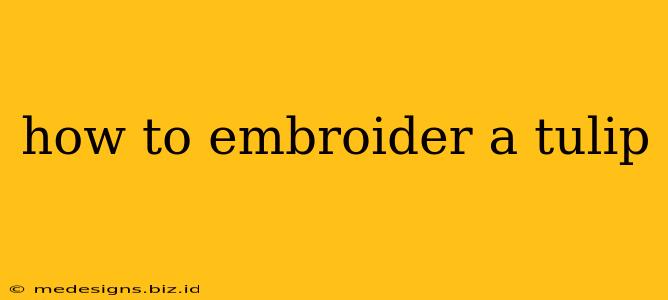Embroidering a tulip is a rewarding project, perfect for beginners and experienced embroiderers alike. This guide will walk you through the process, from choosing your materials to completing your stunning floral design. Let's get started!
Choosing Your Materials: Setting the Stage for Success
Before you begin stitching, gathering the right materials is crucial. This will ensure a smooth and enjoyable embroidery experience.
Essential Supplies for Your Embroidery Project:
- Embroidery Hoop: Choose a size appropriate for your design. A 6-inch hoop is a good starting point for a single tulip.
- Embroidery Fabric: Evenweave fabric is ideal for embroidery beginners due to its even, consistent weave. Aida cloth is another popular choice. Choose a color that complements your tulip design.
- Embroidery Floss: Select floss colors that capture the vibrancy of a tulip. Consider shades of red, orange, yellow, pink, or even purple, depending on the variety you want to embroider. DMC floss is a widely-available and high-quality option.
- Embroidery Needles: Choose needles with a sharp point and a size appropriate for your fabric and floss. Size 7 or 8 needles typically work well for evenweave fabrics.
- Scissors: Sharp embroidery scissors are essential for precise cutting of your floss.
- Water-soluble Pen or Fabric Marker: This will be used to transfer your tulip design onto the fabric.
Transferring Your Tulip Design: Getting Started
Now that you have your materials, it's time to transfer your tulip design onto your fabric.
Methods for Transferring Your Design:
- Tracing Paper and Carbon Paper: This traditional method involves placing your design face down on carbon paper, then placing it on your fabric, and tracing the design.
- Water-Soluble Pen: This is a more modern method, allowing you to directly draw your design onto the fabric. The lines will easily wash away once you’ve finished embroidering.
Stitching Your Tulip: Bringing Your Design to Life
Now for the fun part: stitching! We'll focus on a few basic stitches perfect for embroidering a tulip.
Basic Stitches for Your Tulip Embroidery:
- Stem Stitch: This is ideal for creating the tulip's stem and leaves. It’s a simple yet elegant stitch that creates a clean, defined line.
- French Knots: Use French knots to create the center of the tulip, adding texture and depth.
- Satin Stitch: Use satin stitch to fill in the tulip petals, creating a smooth and solid color. This stitch can be more challenging for beginners, so practice on scrap fabric first.
Detailed Stitch Instructions: Detailed instructions for each stitch can be found through online tutorials or embroidery books. Searching for "stem stitch tutorial," "French knot tutorial," or "satin stitch tutorial" on YouTube will provide many visual guides.
Finishing Touches: Showcasing Your Creation
Once your tulip is complete, carefully remove any remaining transfer marks (if applicable) with water. Gently wash your finished piece in cool water to remove any residue. Then, allow it to air dry completely.
Beyond the Basic Tulip: Expanding Your Embroidery Skills
Once you’ve mastered this beautiful tulip design, why not try experimenting?
Advanced Techniques & Design Variations:
- Varying Tulip Colors: Experiment with different color combinations for a unique look.
- Adding Leaves and Buds: Expand your design to include additional elements like leaves and buds for a more complete arrangement.
- Embroidering on Different Fabrics: Explore different fabric types, such as linen or cotton.
Embroidering a tulip is a relaxing and rewarding craft. With patience and practice, you'll create a beautiful piece of art to cherish, or to give as a thoughtful gift. So gather your supplies and start stitching!
